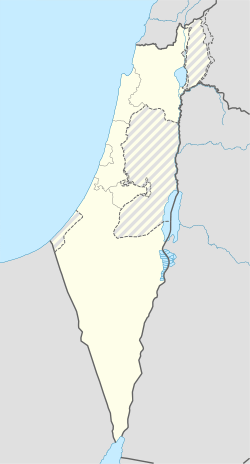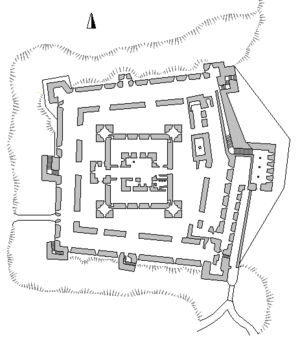Belvoir Castle (Israel) facts for kids

The remains of Belvoir Castle. Note the two circuits of defensive wall, one inside the other (Concentric castle)
|
|
| Location | |
|---|---|
| Region | Northern District |
| Coordinates | 32°35′44″N 35°31′17″E / 32.59556°N 35.52139°E |
| Site notes | |
| Condition | Ruin |
Belvoir Castle (which means "beautiful view" in French) is an old Crusader castle in northern Israel. It sits on a hill at the edge of the Issachar Plateau, about 20 kilometers (12 miles) south of the Sea of Galilee.
The castle is also known by its Hebrew name, Kochav HaYarden (Hebrew: כוכב הירדן), meaning "Star of the Jordan." Its Arabic name is Kawkab al-Hawa (Arabic: كوكب الهوا), which means "Star of the Wind."
Construction of Belvoir Castle began in 1168. It was built by the Knights Hospitaller, a powerful group of Christian knights. Today, the restored castle is part of Belvoir National Park. It is considered the best-preserved Crusader castle in Israel.
Contents
Why Was Belvoir Castle Built Here?
Belvoir Castle was built in a very important spot. It stands about 500 meters (1,640 feet) above the Jordan River Valley. This high position allowed the castle to control the main route from Gilead into the Kingdom of Jerusalem. This route crossed the nearby Jordan River.
To the north of the castle is the Sea of Galilee. To the west are hills. The castle's location gave it a clear view of the entire area. An old saying describes it as "set amidst the stars like an eagle's nest."
Belvoir Castle: A Look at Its History
Early History of the Belvoir Area
The Hebrew name, Kochav Hayarden, comes from an older Jewish village called Kochava. This village existed nearby during the Roman and Byzantine times.
The Crusader Era: Building a Stronghold
The Knights Hospitaller bought the land for the castle in 1168 from a French nobleman named Velos. As soon as they owned the land, they started building the castle.
Under Gilbert of Assailly, who was the leader of the Knights Hospitaller, the order gained many new castles. Belvoir was the most important of these new strongholds. The castle was a major defense against Muslim armies trying to invade the Crusader Kingdom of Jerusalem from the east.
Belvoir Castle successfully defended against a Muslim attack in 1180. In 1182, a battle known as the Battle of Belvoir Castle took place nearby. It was fought between King Baldwin IV of Jerusalem and the famous Muslim leader Saladin.
After Saladin's victory over the Crusaders at the Battle of Hattin, Belvoir Castle was surrounded and attacked. The siege lasted for a year and a half. The castle's defenders finally surrendered on January 5, 1189. An Arab governor then took control of the castle. In 1219, the ruler in Damascus ordered parts of the castle to be destroyed so it could not be used as a fortress again.
In 1241, Belvoir was given back to the Franks (Crusaders). They controlled it until 1263.
Later Periods: From Village to National Park
During the time of the Ottoman Empire, the castle site became an Arab village called Kawkab al-Hawa. Later, during the 1947-48 conflict, the villagers left the area.
Between 1963 and 1968, the buildings from the Arab village were removed by Israeli authorities. The site was then prepared for archaeological study and preservation.
Belvoir Castle: Its Unique Design
After World War II, experts began to study Crusader castles more closely. A significant discovery was made at Belvoir Castle. Between 1963 and 1968, the Israel Antiquities Authority carried out excavations at the castle.
Before these excavations, people thought Belvoir was a simple castle with just one wall. However, the digs showed that it was much more complex. Belvoir's design was similar to an old Roman fort. It had an inner rectangular area with towers at the corners. There was also a large gatehouse in the middle of one wall, on the west side.
Belvoir is an early example of a concentric castle. This type of castle has two or more rings of defensive walls, one inside the other. The inner wall is usually taller than the outer wall. This design was later used in many other Crusader castles.
The castle was very symmetrical. It had a rectangular outer wall with square towers at the corners and along each side. Inside this, there was a square inner area with four corner towers and one on the west wall. This concentric design was very important and influenced castle building for hundreds of years.
Inside both the inner and outer walls, there were vaulted rooms. These rooms provided storage space and protection during attacks. The entire castle was surrounded by a deep moat, about 20 meters (65 feet) wide and 12 meters (39 feet) deep.
See also
 In Spanish: Fortaleza de Belvoir para niños
In Spanish: Fortaleza de Belvoir para niños
- Belvoir disambiguation page
- Archaeology of Israel
- National parks of Israel
- Tourism in Israel




